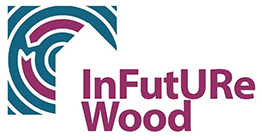CaReWood (Cascade Recovered Wood) is an European project that had the aim to introduce an upgrading concept for recovered solid timber as a source of clean and reliable secondary wooden products for the European industry. The project took place between 2014 and 2017.
Two of the participants in the project recentely defended their PhD thesis:
François Privat from FCBA, France and
Michael Risse from the Technical University of Munich, Germany.
Congratulations for your inspiring work!
François Privat’s thesis is called “The feasibility of post-consumer solid wood waste closed-loop recycling”, and it looks at the technical, economic and environmental feasibility.
From the thesis abstract: “The characterization of Class B wood waste (not pressure-treated) obtained from recycling centres indicates the potential of manufacturing glued laminated joinery planks. An industrial process for homogenizing the properties has been developed and tested, which includes: purging of metals, decontamination and cutting to lamellae, purging of defects, finger-jointing and laminating the slats to make laminated products.
It is demonstrated that removing 2 mm from the surface permits the production of lamellae that have contamination levels lower than the limits used by the particleboard sector. The material yield of lamellae was optimized using a numerical model, then validated and completed by experimentation on the whole process at the pilot scale (a 30 % yield is obtained for products matching class J30 made of 20 mm × 60 mm lamellae). Mechanical tests showed properties similar to the reference values for classes C30 or GL24h and no influence of aging was observed.”
For those who would like to find out more details about the work in France here is an article on the subject called:
Advanced recycling of post-consumer solid wood and MDF
For French speakers here is a presentation made by prof. Mark Irle in 2017 on the results of CaReWood.
Michael Risses’s thesis is called: “Resource and eco-efficiency assessment of utilizing recovered solid wood in cascades” and it analysed the resource use and the resource efficiency of wood cascading system in comaprison with e reference system based on primary wood using exergy analysis.
From the thesis abstract: “For a newly developed technology to recycle recovered solid wood into clean and standardized lamellae for further material use, the eco-efficiency is determined using a joint analysis of Life Cycle Assessment and Life Cycle Costing in comparison to a current treatment alternative. The machining concept was developed within the framework of the project Cascading Recovered Wood.
The environmental impacts and costs of the considered recycling scenarios are up to 29 % and 32 % lower compared to a direct incineration. While the operational processes for the recycling are of minor relevance, present technologies like the lamination and incineration processes are key impact and cost drivers. In general, the material recycling shows a 15-150 % higher eco-efficiency. However, scenario analysis revealed a decisive influence of system expansion modelling on the outcome of the comparison. Scenario analysis and a careful modelling of system expansion processes are therefore recommended to provide transparent results. For the evaluation of emerging wood recycling technologies, qualitative data as well as better knowledge on the properties of recovered wood and its application are crucial for the reliability of future studies.”
Michael is now part of the InFutURe Wood team and brings over a lot of his knowledge. Two of his articles are:


